How To Find Last Date Of Month In Excel
The tutorial explains the nuts and bolts of Excel Month and EOMONTH functions. Y'all will find an assortment of formula examples demonstrating how to extract month from date in Excel, become the get-go and last mean solar day of the month, convert month name to number and more than.
In the previous commodity, nosotros explored a diverseness of Excel functions to work with weekdays and days of year. Today, we are going to operate on a bigger fourth dimension unit and learn the functions that Microsoft Excel provides for months.
In this tutorial, you lot volition learn:
Excel MONTH part - syntax and uses
Microsoft Excel provides a special MONTH part to extract a month from date, which returns the month number ranging from 1 (January) to 12 (December).
The Calendar month function can be used in all versions of Excel 2016 - 2000 and its syntax is every bit simple every bit it tin can possibly be:
MONTH(serial_number)
Where serial_number is whatever valid engagement of the calendar month you are trying to detect.
For the correct work of Excel Calendar month formulas, a date should exist entered by using the DATE(year, month, day) function. For example, the formula =MONTH(DATE(2015,3,1)) returns 3 since Engagement represents the 1st 24-hour interval of March, 2015.
Formulas similar =Month("ane-Mar-2015") also work fine, though problems may occur in more complex scenarios if dates are entered as text.
In practice, instead of specifying a engagement within the Calendar month office, it'due south more convenient to refer to a jail cell with a date or supply a engagement returned by some other function. For example:
=Month(A1) - returns the month of a appointment in cell A1.
=MONTH(TODAY()) - returns the number of the electric current month.
At get-go sight, the Excel MONTH function may wait plain. But look through the below examples and you will be amazed to know how many useful things information technology tin can actually do.
How to get month number from engagement in Excel
There are several ways to go month from date in Excel. Which one to choose depends on exactly what upshot you are trying to achieve.
- Calendar month function in Excel - get month number from date.
This is the nearly obvious and easiest way to convert date to calendar month in Excel. For example:
-
=Month(A2)- returns the month of a appointment in prison cell A2. -
=Month(Date(2015,4,15))- returns 4 corresponding to April. -
=MONTH("xv-Apr-2015")- evidently, returns number 4 besides.
-
- TEXT function in Excel - extract month as a text string.
An culling way to get a calendar month number from an Excel appointment is using the TEXT function:
-
=TEXT(A2, "m")- returns a month number without a leading zero, as 1 - 12. -
=TEXT(A2,"mm")- returns a calendar month number with a leading zip, as 01 - 12.
Please exist very careful when using TEXT formulas, because they e'er return calendar month numbers as text strings. So, if y'all program to perform some further calculations or use the returned numbers in other formulas, you lot'd amend stick with the Excel Calendar month office.
-
The following screenshot demonstrates the results returned by all of the above formulas. Please notice the right alignment of numbers returned by the MONTH role (cells C2 and C3) as opposed to left-aligned text values returned by the TEXT functions (cells C4 and C5).
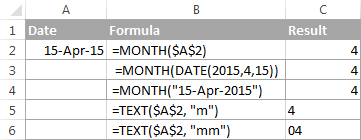
How to extract calendar month proper name from date in Excel
In case y'all want to become a month proper noun rather than a number, you use the TEXT function again, but with a unlike appointment code:
-
=TEXT(A2, "mmm")- returns an abbreviated month name, equally Jan - Dec. -
=TEXT(A2,"mmmm")- returns a full calendar month name, equally January - Dec.

If you lot don't actually desire to convert engagement to month in your Excel worksheet, you are just wish to display a month name only instead of the total engagement, then you don't want any formulas.
Select a prison cell(s) with dates, press Ctrl+1 to opent the Format Cells dialog. On the Number tab, select Custom and type either "mmm" or "mmmm" in the Type box to display abbreviated or total month names, respectively. In this case, your entries will remain fully functional Excel dates that you can use in calculations and other formulas. For more details virtually changing the date format, please meet Creating a custom date format in Excel.

How to convert month number to month proper noun in Excel
Suppose, yous have a list of numbers (1 through 12) in your Excel worksheet that you want to convert to calendar month names. To practise this, you tin can use any of the following formulas:
- To return an abbreviated month name (Jan - December).
=TEXT(A2*28, "mmm")=TEXT(Date(2015, A2, 1), "mmm") - To return a full month proper name (January - Dec).
=TEXT(A2*28, "mmmm")=TEXT(DATE(2015, A2, 1), "mmmm")In all of the in a higher place formulas, A2 is a cell with a month number. And the only real difference between the formulas is the month codes:
- "mmm" - 3-letter abbreviation of the calendar month, such as Jan - December
- "mmmm" - calendar month spelled out completely
- "mmmmm" - the first letter of the alphabet of the month name
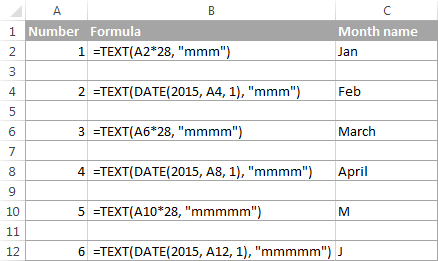
How these formulas work
When used together with month format codes such as "mmm" and "mmmm", Excel considers the number 1 as Twenty-four hours ane in January 1900. Multiplying 1, 2, 3 etc. past 28, you are getting Days 28, 56, 84, etc. of the yr 1900, which are in January, February, March, etc. The format code "mmm" or "mmmm" displays just the month name.
How to convert calendar month proper name to number in Excel
In that location are two Excel functions that can aid you convert month names to numbers - DATEVALUE and Month. Excel's DATEVALUE part converts a engagement stored equally text to a serial number that Microsoft Excel recognizes every bit a date. And so, the MONTH role extracts a month number from that appointment.
The consummate formula is as follows:
=MONTH(DATEVALUE(A2 & "one"))
Where A2 in a cell containing the month name you want to turn into a number (&"1" is added for the DATEVALUE office to understand it's a appointment).
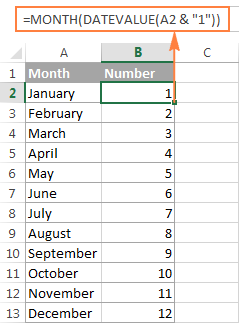
How to go the last solar day of calendar month in Excel (EOMONTH role)
The EOMONTH office in Excel is used to return the last day of the calendar month based on the specified start date. It has the following arguments, both of which are required:
EOMONTH(start_date, months)
- Start_date - the starting date or a reference to a prison cell with the start engagement.
- Months - the number of months before or afterwards the first date. Use a positive value for future dates and negative value for past dates.
Here are a few EOMONTH formula examples:
=EOMONTH(A2, one) - returns the last twenty-four hours of the month, one month later the date in cell A2.
=EOMONTH(A2, -1) - returns the final day of the month, ane calendar month before the date in cell A2.
Instead of a cell reference, you can hardcode a date in your EOMONTH formula. For example, both of the beneath formulas return the concluding twenty-four hour period in April.
=EOMONTH("fifteen-Apr-2015", 0)
=EOMONTH(Date(2015,4,15), 0)
To return the terminal solar day of the current calendar month, yous employ the TODAY() function in the outset argument of your EOMONTH formula and then that today's appointment is taken every bit the start engagement. And, you put 0 in the months argument because y'all don't desire to change the calendar month either way.
=EOMONTH(TODAY(), 0)
Notation. Since the Excel EOMONTH office returns the serial number representing the date, you lot have to utilize the date format to a jail cell(southward) with your formulas. Please see How to change date format in Excel for the detailed steps.
And here are the results returned by the Excel EOMONTH formulas discussed in a higher place:
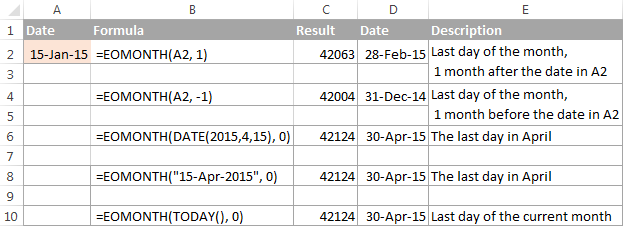
If you lot want to summate how many days are left till the terminate of the electric current month, you simply decrease the appointment returned by TODAY() from the date returned by EOMONTH and apply the General format to a jail cell:
=EOMONTH(TODAY(), 0)-TODAY()
How to find the showtime day of month in Excel
As you already know, Microsoft Excel provides just one office to return the last day of the calendar month (EOMONTH). When it comes to the first day of the month, there is more than one manner to get information technology.
Example ane. Get the onest twenty-four hour period of calendar month by the month number
If you have the month number, then use a unproblematic DATE formula like this:
=DATE(yr, month number, 1)
For example, =DATE(2015, 4, ane) will return i-Apr-15.
If your numbers are located in a certain column, say in cavalcade A, yous can add together a jail cell reference directly in the formula:
=Engagement(2015, B2, 1)

Example 2. Get the 1st day of month from a engagement
If you desire to calculate the first twenty-four hours of the month based on a appointment, you tin can use the Excel DATE function again, simply this fourth dimension you will also demand the MONTH function to extract the month number:
=Engagement(twelvemonth, Calendar month(cell with the date), 1)
For example, the following formula will render the showtime day of the calendar month based on the date in prison cell A2:
=Date(2015,Month(A2),1)
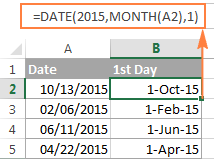
Instance 3. Find the first day of month based on the current date
When your calculations are based on today'southward engagement, apply a liaison of the Excel EOMONTH and TODAY functions:
=EOMONTH(TODAY(),0) +one - returns the anest day of the following month.
As you retrieve, nosotros already used a similar EOMONTH formula to get the last day of the current month. And now, y'all simply add ane to that formula to get the first day of the next calendar month.
In a similar mode, you can get the first day of the previous and current month:
=EOMONTH(TODAY(),-2) +1 - returns the anest mean solar day of the previous month.
=EOMONTH(TODAY(),-1) +1 - returns the ist mean solar day of the current month.
You could also apply the Excel DATE role to handle this task, though the formulas would be a bit longer. For example, gauge what the post-obit formula does?
=Engagement(Year(TODAY()), Calendar month(TODAY()), i)
Yeah, it returns the first day of the current month.
And how do you force information technology to return the first 24-hour interval of the following or previous month? Hands down :) Just add or subtract 1 to/from the current month:
To return the starting time day of the following calendar month:
=DATE(Year(TODAY()), Calendar month(TODAY())+1, 1)
To return the get-go twenty-four hour period of the previous month:
=DATE(YEAR(TODAY()), MONTH(TODAY())-one, one)
How to calculate the number of days in a month
In Microsoft Excel, there exist a multifariousness of functions to work with dates and times. However, it lacks a function for calculating the number of days in a given month. So, we'll need to make up for that omission with our ain formulas.
Example 1. To get the number of days based on the month number
If yous know the calendar month number, the post-obit 24-hour interval / DATE formula volition return the number of days in that month:
=Solar day(DATE(year, month number + 1, 1) -ane)
In the above formula, the Date function returns the first twenty-four hours of the following month, from which you decrease 1 to get the last day of the month you want. And so, the 24-hour interval part converts the appointment to a solar day number.
For example, the following formula returns the number of days in April (the 4thursday month in the twelvemonth).
=Twenty-four hours(DATE(2015, 4 +one, 1) -1)
Instance 2. To go the number of days in a month based on date
If you don't know a month number but have whatsoever date within that month, you tin use the YEAR and Month functions to extract the year and month number from the date. Just embed them in the DAY / Engagement formula discussed in the higher up case, and information technology will tell you how many days a given month contains:
=Day(DATE(Year(A2), Month(A2) +one, 1) -1)
Where A2 is jail cell with a date.
Alternatively, you tin can use a much simpler Twenty-four hours / EOMONTH formula. As you remember, the Excel EOMONTH function returns the last twenty-four hour period of the month, and then y'all don't need whatsoever additional calculations:
=DAY(EOMONTH(A1, 0))
The post-obit screenshot demonstrates the results returned by all of the formulas, and as you run across they are identical:

How to sum information by calendar month in Excel
In a big tabular array with lots of data, you may often demand to become a sum of values for a given month. And this might be a problem if the data was non entered in chronological order.
The easiest solution is to add together a helper column with a simple Excel MONTH formula that will convert dates to month numbers. Say, if your dates are in cavalcade A, yous apply =Month(A2).
And now, write downward a list of numbers (from one to 12, or only those month numbers that are of involvement to you) in an empty column, and sum values for each month using a SUMIF formula similar to this:
=SUMIF(C2:C15, E2, B2:B15)
Where E2 is the month number.
The following screenshot shows the issue of the calculations:

If you'd rather not add a helper column to your Excel canvass, no problem, you lot can do without it. A scrap more than trickier SUMPRODUCT function will work a treat:
=SUMPRODUCT((Calendar month($A$2:$A$xv)=$E2) * ($B$ii:$B$fifteen))
Where column A contains dates, cavalcade B contains the values to sum and E2 is the month number.
Annotation. Please keep in mind that both of the above solutions add upwards all values for a given calendar month regardless of the year. So, if your Excel worksheet contains information for several years, all of it volition be summed.
How to conditionally format dates based on calendar month
Now that you know how to use the Excel MONTH and EOMONTH functions to perform various calculations in your worksheets, you may accept a footstep further and amend the visual presentation. For this, nosotros are going to use the capabilities of Excel conditional formatting for dates.
In addition to the examples provided in the above mentioned article, now I will evidence you how you tin can speedily highlight all cells or entire rows related to a sure month.
Example 1. Highlight dates inside the current month
In the tabular array from the previous example, suppose you want to highlight all rows with the current calendar month dates.
First off, you lot extract the month numbers from dates in column A using the simplest =Month($A2) formula. And then, you compare those numbers with the current month returned by =MONTH(TODAY()). As a issue, you have the following formula which returns True if the months' numbers match, FALSE otherwise:
=MONTH($A2)=MONTH(TODAY())
Create an Excel provisional formatting dominion based on this formula, and your result may resemble the screenshot below (the article was written in April, and then all Apr dates are highlighted).

Example 2. Highlighting dates past month and 24-hour interval
And here's another claiming. Suppose you want to highlight the major holidays in your worksheet regardless of the twelvemonth. Let's say Christmas and New year's day days. How would you approach this chore?
Simply use the Excel 24-hour interval part to extract the solar day of the calendar month (1 - 31) and the Month function to get the calendar month number, and and so bank check if the 24-hour interval is equal to either 25 or 31, and if the Calendar month is equal to 12:
=AND(OR(DAY($A2)=25, Mean solar day($A2)=31), MONTH(A2)=12)

This is how the Month function in Excel works. Information technology appears to be far more versatile than information technology looks, huh?
In a couple of the side by side posts, nosotros are going to summate weeks and years and hopefully you will learn a few more useful tricks. If you are interested in smaller time units, please check out the previous parts of our Excel Dates serial (you will observe the links below). I thank you for reading and promise to encounter you next week!
You may also be interested in
Source: https://www.ablebits.com/office-addins-blog/2015/04/22/excel-month-eomonth-functions/
Posted by: joinernessiogs.blogspot.com


0 Response to "How To Find Last Date Of Month In Excel"
Post a Comment